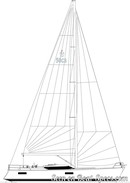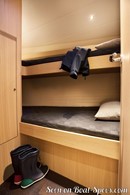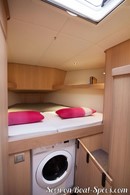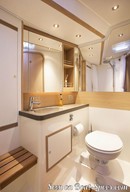Contest 50CS Standard
Sailboat specifications
The Contest 50CS is a 49’2” (14.99m) cruising sailboat designed by Georg Nissen Yacht Design (Germany). She is built since 2006 by Conyplex (Netherlands).
Contest 50CS's main features
- Model
- Contest 50CS
- Version
- Standard
- Hull type
- Monohull
- Category
- Offshore cruising sailboat
- Sailboat builder
- Sailboat designer
- Sailboat range
- Country
- Netherlands
- Construction
- GRP (glass reinforced polyester):
- Hull: Sandwich E-glass vinylester (vacuum infusion)
- Deck: Sandwich E-glass vinylester (vacuum infusion) - First built hull
- 2006
- Last built hull
- Still in production
- Appendages
- Keel : fin with bulb
- Helm
- Single helm wheel
- Rudder
- Single spade rudder
- Unsinkable
- No
- Trailerable
- No
- EC design categoryiThe CE design category indicates the ability to cope with certain weather conditions (the sailboat is designed for these conditions)
A: Wind < force 9, Waves < 10m
B: Wind < force 8, Waves < 8m
C: Wind < force 6, Waves < 4m
D: Wind < force 4, Waves < 0,5m - A
- Standard public price ex. VAT (indicative only)
- N/A €
Contest 50CS's main dimensions
- Overall length
- 49’ 2”14.99 m
- Hull length
- 49’ 2”14.99 m
- Waterline length
- 43’ 1”13.13 m
- Beam (width)
- 15’4.58 m
- Draft
- 7’ 1”2.15 m
- Mast height from DWL
- 77’ 4”23.55 m
- Light displacement (MLC)
- 38581 lb17500 kg
- Ballast weight
- 13448 lb6100 kg
- Ballast type
- Cast iron fin with lead bulb
Contest 50CS's rig and sails
- Upwind sail area
- 1345 ft²125 m²
- Mainsail area
- 721 ft²67 m²
- Genoa area
- 624 ft²58 m²
- Rigging type
- Sloop Marconi 19/20
- Mast configuration
- Keel stepped mast
- Rotating spars
- No
- Number of levels of spreaders
- 3
- Spreaders angle
- Swept-back
- Spars construction
- Aluminum spars (carbon fiber spars as an option)
- Standing rigging
- 1x19 strand wire discontinuous
Contest 50CS's performances
- Upwind sail area to displacementiThe ratio sail area to displacement is obtained by dividing the sail area by the boat's displaced volume to the power two-thirds.
The ratio sail area to displacement can be used to compare the relative sail plan of different sailboats no matter what their size.
Upwind: under 18 the ratio indicates a cruise oriented sailboat with limited performances especially in light wind, while over 25 it indicates a fast sailboat. - 200 ft²/T18.54 m²/T
- Displacement-length ratio (DLR)iThe Displacement Length Ratio (DLR) is a figure that points out the boat's weight compared to its waterline length. The DLR is obtained by dividing the boat's displacement in tons by the cube of one one-hundredth of the waterline length (in feet).
The DLR can be used to compare the relative mass of different sailboats no matter what their length:
a DLR less than 180 is indicative of a really light sailboat (race boat made for planning), while a DLR greater than 300 is indicative of a heavy cruising sailboat. - 219
- Ballast ratioiThe Ballast ratio is an indicator of stability; it is obtained by dividing the boat's displacement by the mass of the ballast. Since the stability depends also of the hull shapes and the position of the center of gravity, only the boats with similar ballast arrangements and hull shapes should be compared.
The higher the ballast ratio is, the greater is the stability. - 35 %
- Maximum righting momentiThe righting moment is a moment (torque) that tends to restore a boat to its previous position after heeling. Its value corresponds to the torque needed to heel the boat for this angle.
Higher the righting moment is for an angle, greater is the stability. - 115728 lb.ft16000 kg.m @ 55.00 °
- Critical hull speediAs a ship moves in the water, it creates standing waves that oppose its movement. This effect increases dramatically the resistance when the boat reaches a speed-length ratio (speed-length ratio is the ratio between the speed in knots and the square root of the waterline length in feet) of about 1.2 (corresponding to a Froude Number of 0.35) . This very sharp rise in resistance, between speed-length ratio of 1.2 to 1.5, is insurmountable for heavy sailboats and so becomes an apparent barrier. This leads to the concept of "hull speed".
The hull speed is obtained by multiplying the square root of the waterline length (in feet) by 1.34. - 8.79 knots
Contest 50CS's auxiliary engine
- Engine(s)
- 1 inboard engine
- Engine(s) power
- 110 HP
- Fuel type
- Diesel
- Fuel tank capacity
- 149 gal564 liters
Contest 50CS's accommodations and layout
- Cockpit
- Center cockpit
- Cabin(s) (min./max.)
- 2 / 3
- Berth(s) (min./max.)
- 4 / 8
- Head(s)
- 2
- Freshwater tank capacity
- 189.7 gal718 liters
- Boiler capacity
- 10.6 gal40 liters



Conyplex Contest 50CS sailplan - - 2/14
Picture extracted from the commercial documentation © Conyplex
Picture extracted from the commercial documentation © Conyplex






Conyplex Contest 50CS sailing - - 7/14
Picture extracted from the commercial documentation © Conyplex
Picture extracted from the commercial documentation © Conyplex


Conyplex Contest 50CS sailing - - 8/14
Picture extracted from the commercial documentation © Conyplex
Picture extracted from the commercial documentation © Conyplex


Conyplex Contest 50CS sailing - - 9/14
Picture extracted from the commercial documentation © Conyplex
Picture extracted from the commercial documentation © Conyplex


Conyplex Contest 50CS interior and accommodations - - 10/14
Picture extracted from the commercial documentation © Conyplex
Picture extracted from the commercial documentation © Conyplex


Conyplex Contest 50CS interior and accommodations - - 11/14
Picture extracted from the commercial documentation © Conyplex
Picture extracted from the commercial documentation © Conyplex


Conyplex Contest 50CS interior and accommodations - - 12/14
Picture extracted from the commercial documentation © Conyplex
Picture extracted from the commercial documentation © Conyplex


Conyplex Contest 50CS interior and accommodations - - 13/14
Picture extracted from the commercial documentation © Conyplex
Picture extracted from the commercial documentation © Conyplex


Conyplex Contest 50CS interior and accommodations - - 14/14
Picture extracted from the commercial documentation © Conyplex
Picture extracted from the commercial documentation © Conyplex
Similar sailboats that may interest you:
Sailboats
First built hull
Hull length
2012
47’ 6”14.48 m
2014
48’ 8”14.85 m
2010
49’ 2”14.99 m
2004
49’ 2”14.99 m
2014
49’ 2”14.99 m
1988
52’ 6”16 m
2013
52’ 11”16.12 m
2013
52’ 11”16.12 m
2000
52’ 6”16 m
2017
50’ 11”15.51 m
2009
47’ 10”14.58 m
2016
48’ 6”14.77 m
2013
42’ 2”12.85 m
2005
44’ 11”13.7 m
2010
56’ 6”17.23 m